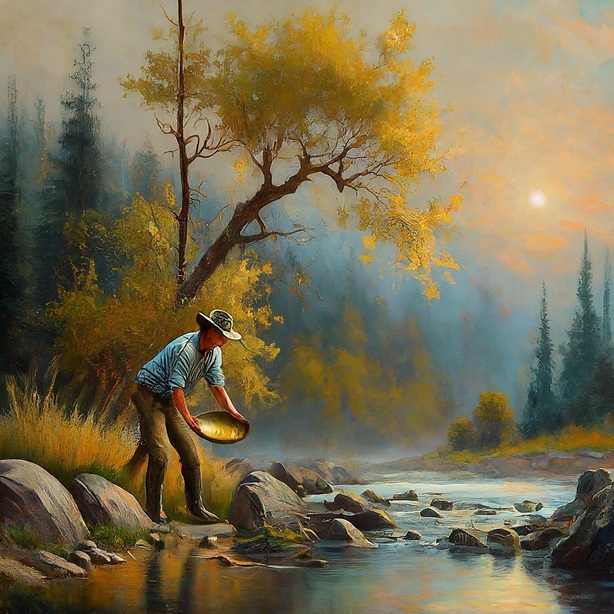
Gold prospecting, the age-old pursuit of hunting for gold nuggets and flakes, continues to captivate the imagination of adventurers and treasure hunters worldwide. Whether you’re drawn to the thrill of discovery or the potential for striking it rich, embarking on a gold prospecting journey can be both rewarding and exhilarating. In this beginner’s guide, we’ll explore the essential tips, techniques, and equipment you’ll need to start your own gold prospecting adventure, from choosing the right location to selecting the best equipment and selling your precious finds.
Tips for Gold Prospecting
Research and Education: Before heading out into the wilderness, arm yourself with knowledge about gold prospecting techniques, geological formations, and the history of gold mining in your area.
Choose the Right Location: Look for areas with a history of gold mining or geological features conducive to gold deposition, such as rivers, streams, and exposed bedrock.
Practice Patience: Gold prospecting requires patience and perseverance. Don’t get discouraged if you don’t strike gold right away; persistence is key.
Learn to Read the Landscape: Develop an eye for spotting potential gold-bearing areas by observing geological clues such as quartz veins, iron deposits, and evidence of past water flow.
Use the Right Tools: Invest in quality prospecting tools, including metal detectors, gold pans, sluice boxes, and crevice tools, to maximize your chances of success.
Respect Nature and Regulations: Always obtain the necessary permits and permissions before prospecting on public or private land, and leave the environment as you found it.
Where to Go Gold Prospecting
Rivers and Streams: Gold tends to settle in the sediment of rivers and streams, particularly in areas where the water flow slows down, such as bends, riffles, and behind large rocks.
Old Mining Sites: Explore abandoned mines and mining camps where gold may have been overlooked or left behind by early prospectors.
Desert Regions: Dry washes and arid regions can also yield gold deposits, as the lack of vegetation makes it easier to spot gold-bearing material.
Public Lands: Many national forests, parks, and Bureau of Land Management (BLM) areas allow recreational gold prospecting, offering vast stretches of land to explore.
Join a Club or Group: Consider joining a local gold prospecting club or group to gain access to exclusive claims, learn from experienced prospectors, and share in the camaraderie of the gold hunting community.
Best Gold Prospecting Equipment
Metal Detectors: A high-quality metal detector is essential for locating buried gold nuggets and flakes buried beneath the surface.
Gold Pans: Gold pans are indispensable for separating gold from other sediment and materials. Look for pans with riffles and a wide base for efficient gold recovery.
Sluice Boxes: Sluice boxes are used to process larger quantities of material, allowing for more efficient gold recovery by capturing gold particles in riffles as water flows through the box.
Crevice Tools: Crevice tools are handy for extracting gold from cracks and crevices in bedrock, where gold can accumulate out of reach of other prospecting tools.
Dredges and Highbankers: For prospectors looking to process larger volumes of material, dredges and highbankers offer efficient methods for extracting gold from riverbeds and streambanks.
Safety Gear: Don’t forget to invest in essential safety gear, including sturdy footwear, sun protection, and plenty of water to stay hydrated while prospecting in remote areas.
Selling Your Gold
Research Market Prices: Before selling your gold, research current market prices to ensure you get a fair value for your precious finds.
Local Buyers and Refiners: Consider selling your gold to local buyers or refiners who specialize in purchasing raw gold from small-scale prospectors.
Online Marketplaces: Online marketplaces and auction sites offer a platform for selling gold directly to buyers worldwide, but be wary of transaction fees and shipping costs.
Jewelry and Craftsmanship: If you have larger or more significant gold specimens, consider selling them to jewelers or craftsmen who can transform them into unique pieces of jewelry or art.
Embarking on a gold prospecting adventure is an exhilarating journey that combines the thrill of exploration with the potential for discovering valuable treasures hidden beneath the earth’s surface. By following these beginner’s tips and techniques, choosing the right locations, investing in quality equipment, and exploring responsibly, you can maximize your chances of success and unlock the excitement of striking gold. So grab your gear, head out into the wilderness, and start your own gold prospecting adventure today!
